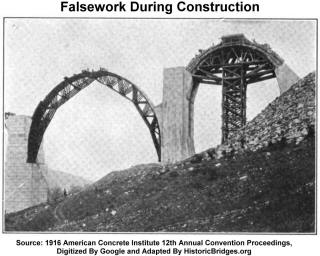We Recommend:
Bach Steel - Experts at historic truss bridge restoration.
BridgeHunter.com Phase 1 is released to the public! - Visit Now
Tunkhannock Viaduct
Nicholson Bridge

Primary Photographer(s): Nathan Holth and Rick McOmber
Bridge Documented: May 26, 2007, November 2015, April 2016
Railroad (St Lawrence and Hudson / Norfolk Southern) Over Tunkhannock Creek
Nicholson: Wyoming County, Pennsylvania: United States
1915 By Builder/Contractor: Flickwir and Bush of New York, New York and Engineer/Design: Abraham Burton Cohen
1940
180.0 Feet (54.9 Meters)
2,375.0 Feet (723.9 Meters)
34 Feet (10.36 Meters)
12 Main Span(s)
Not Applicable

View Information About HSR Ratings
Bridge Documentation
View Historic American Engineering Record (HAER) Documentation For This Bridge
HAER Data Pages, PDF
View A Website Dedicated To The September 2015 100th Anniversary Celebration For This Bridge
View Historical Articles About This Bridge
Among the greatest bridges in the world is the famous Tunkhannock Viaduct, which has been called the 9th Wonder of the World. It truly is impressive to see a bridge that is so large and tall that it soars above the hills of Pennsylvania.
Concrete had not really been in use for bridge building all that long (mainly starting around 1900), when this bridge was built in 1915. This did not stop builders from constructing this bridge that would become the largest concrete bridge in the world. As late as 1990, this bridge appears to have retained this record as largest concrete bridge in the world. Further testimony to the significance of this bridge is the fact it has been registered as a National Historic Civil Engineering Landmark, one of the most elite historic designations a bridge can receive.
The construction of this bridge caused the town, which had a population of 900 to add 2600 people to its population. The actual workforce for the bridge was about 500 people.
Be sure to view the photo gallery for pictures of a much more extensive historical narrative of this bridge (which is located at an interpretive area near the bridge itself) that also includes photos of its construction. To go even more in-depth, be sure to view the collection of articles that HistoricBridges.org compiled for convenient viewing. These articles discuss numerous aspects of the bridge and also include photos and drawings.
Concrete railings were added to the bridge in 1940. Interestingly, those have proved less durable than the 1915 bridge, and are deteriorating. The repair of these should be considered simply to improve the aesthetic quality of the bridge. Certainly, the need to maintain and preserve the bridge itself is of paramount importance, however for how old the bridge is, it seems to be in excellent condition currently.

If you visit this bridge, don't forget to travel north a short distance and visit its "little" brother, the Kingsley Bridge, which when you take the Tunkhannock Viaduct out of the picture, is a very large and impressive bridge as well, as is also well-worth a visit.
There is also supposed to be a very long tunnel on this railroad line nearby, although this website unfortunately did not have time to check it out.
The Nazareth Cement Company supplied the cement used to construct this concrete bridge.

![]()
Photo Galleries and Videos: Tunkhannock Viaduct
2015-6 Bridge Photo-Documentation
Original / Full Size PhotosA collection of overview and detail photos. This gallery offers photos in the highest available resolution and file size in a touch-friendly popup viewer.
Alternatively, Browse Without Using Viewer
![]()
2015-6 Bridge Photo-Documentation
Mobile Optimized PhotosA collection of overview and detail photos. This gallery features data-friendly, fast-loading photos in a touch-friendly popup viewer.
Alternatively, Browse Without Using Viewer
![]()
2007 Bridge Photo-Documentation
A collection of overview and detail photos. This photo gallery contains a combination of Original Size photos and Mobile Optimized photos in a touch-friendly popup viewer.Alternatively, Browse Without Using Viewer
![]()
Maps and Links: Tunkhannock Viaduct
Coordinates (Latitude, Longitude):
Search For Additional Bridge Listings:
Bridgehunter.com: View listed bridges within 0.5 miles (0.8 kilometers) of this bridge.
Bridgehunter.com: View listed bridges within 10 miles (16 kilometers) of this bridge.
Additional Maps:
Google Streetview (If Available)
GeoHack (Additional Links and Coordinates)
Apple Maps (Via DuckDuckGo Search)
Apple Maps (Apple devices only)
Android: Open Location In Your Map or GPS App
Flickr Gallery (Find Nearby Photos)
Wikimedia Commons (Find Nearby Photos)
Directions Via Sygic For Android
Directions Via Sygic For iOS and Android Dolphin Browser
USGS National Map (United States Only)
Historical USGS Topo Maps (United States Only)
Historic Aerials (United States Only)
CalTopo Maps (United States Only)







